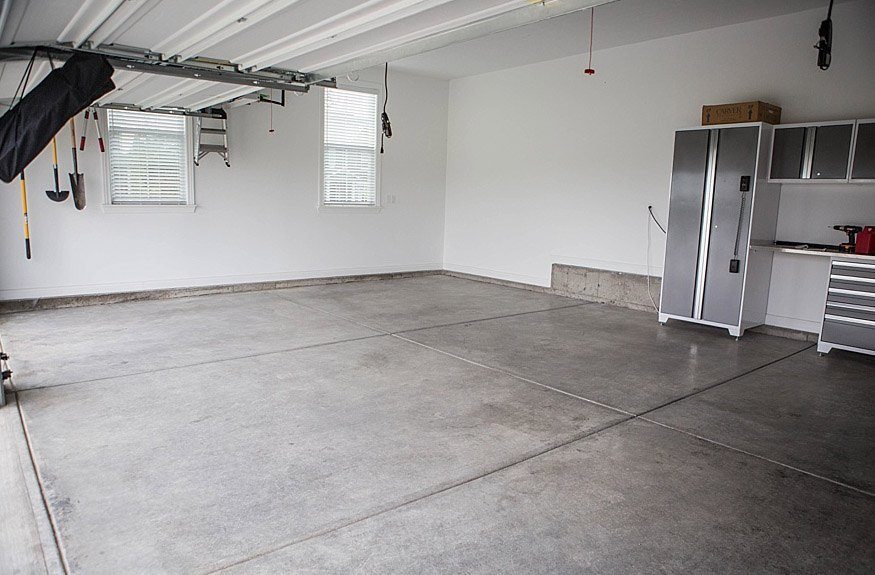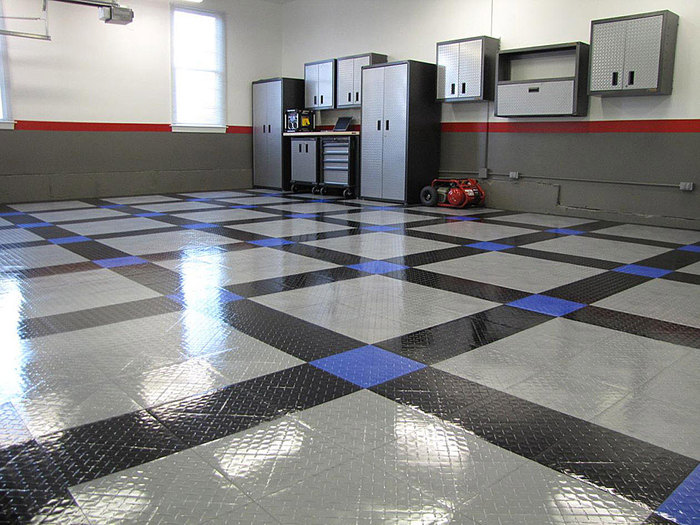Any garage concrete floor needs a good coating to protect it from damage. Many garage owners decide to install a specific flooring as it helps with strengthening the surface, makes the cleaning process easier and creates a definitely interesting look for the garage interior.
For garage flooring, the requirements are always high. It must withstand heavy weights and stay undamaged no matter what. Spilling gasoline, fuel or other chemicals should not affect its quality as well. If you can’t decide what material it’s better to choose, we hope that this article will be of great help. Here, you will find the most popular types of floor coatings on the market and receive all the necessary recommendations regarding the advantages and disadvantages of materials that you can use.
But if you are only starting to think about building a new garage, we suggest you read our article about types of garages. You might also be interested in learning, how to calculate an optimum garage size. But if you have already got your garage built and started wondering what flooring you should install, keep reading to explore the many options and customize your garage in the best way!
Concrete garage flooring

Concrete is the most affordable flooring material for your garage. Concrete is cheap, easy to make, and easy to apply as well. Concrete flooring is strong and durable, which is why it is widely used in warehouses and industrial buildings. Not every concrete is able to withstand overloads, so do not forget to find local companies that offer you the most durable and resistant coating.
Concrete floor is great, because:
- it is not toxic, therefore safe for health.
- It is easy to maintain.
- It is resistant against weights, fire, and chemicals.
- It dries quickly.
- Modern types of concrete can sometimes look rather aesthetic.
Still, no product is perfect and performs flawlessly. You might want to rethink your decision, because:
- without extra coating (wood, epoxy, resin etc.) concrete is more difficult to take care of.
- it is very cold. We recommend you install a good heating system, else it will be freezing in your garage.
- concrete is too hard for a surface and it might be uncomfortable to stand or walk on it for a long time.
There is also an option for grinding, painting or polishing your concrete floor. It helps with enhancing your garage interior looks and makes your concrete floor easier to clean, but unfortunately, it doesn’t cancel the main disadvantages. All in all, the concrete garage floor is better equipped with some other coating.
Wooden floor in the garage

On the market, there are a lot of materials for your garage flooring. Nevertheless, wood is still one of the most popular materials among car owners.
The main advantages of the wooden flooring are:
- The wood is breathable and keeps you warm, so the temperature in the garage will be comfortable for you. The atmosphere in there will also be quite cozy;
- Shipping wood won’t cost a lot as this material is highly affordable. Any construction company can provide enough wood for your garage, and transportation won’t be difficult at all.
- Working with wood is easy and quick. We all have tried it at least once in our live since we were kids. All the work can be done all by yourself, you won’t need extra help or hire qualified professionals;
- Wood is easy to repair. You can replace a damaged piece of wood with a new one almost anytime.
But there are disadvantages, too:
- Wood is extremely absorbent. After you spill some chemicals, gasoline or fuel on it, it will be almost impossible to remove the stain;
- It decays and rots, and is highly vulnerable against insects;
- Car tires wear the wood down very quickly.
The cons given above are not critical though. To avoid any problems, you should use varnish, antiseptic or paint to protect your wooden flooring and make it more durable. You can also opt for a combined option, too: first, treat your wooden floor with antiseptic. Then, apply paint and varnish.
The wooden coating should be at least 0.8 inches thick to make it work. Specific parameters and wood types are determined by how strong you expect the overloads to be. It is obvious: the heavier the vehicle, the stronger the flooring. Conifer is the best type of wood as it is known for its increased strength and resistance. Oak coating lasts even longer, although it costs much more. But it would be better to avoid using walnut or mahogany as they are too soft.
Mat flooring for your garage

The most convenient option for rubber mats is using tiles. As a rule, the tiles are 20×20 inches, which makes them very customizable and allows you to create patterns on the floor. You can find a wide range of shapes and colors. They are easy to repair, but you might want to buy some extra tiles in advance: in the future, it can be problematic to find the tiles of the same size and color.
Rubber mat tiles withstand severe loads and temperatures. They are water- and oil-proof, resistant to solvents, acids and other aggressive chemicals.
Positive characteristics:
- high elasticity and resistance;
- ability to withstand heavy weights and overloads;
- the coating breathes well and gets no condensation underneath;
- fire-resistant and environment-friendly coating;
- resistance to an aggressive environment;
- sound and heat insulati.
The main weakness of the mat flooring is its installation. The layout requires significant effort and skills. If you have no experience in working with mats, it is better to call a specialist.
After the coating has been laid out, it is highly recommended to treat a perimeter of the garage with sealant.
Epoxy floor topping

Garage owners have long discovered that epoxy suits very well for the garage floor. It isn’t hard to maintain, it cleans easily, but it is attractive and good-looking indeed. The surface of the epoxy flooring is very smooth and resistant. After pouring the epoxy, you can use your garage on the next day already.
Although epoxy might be more expensive to buy and set, the performance of this material will fully pay off. It is highly resistant to vibration, various chemicals, temperature drops, abrasion, etc. No wonder epoxy coating can serve up to 30-40 years or more!
Benefits:
- long-lasting material;
- although the layer isn’t thick, it is excellently waterproof and resistant to high and low temperatures;
- it is vibration-, compression- and bending-resistant;
- washes easily and doesn’t accumulate dirt and dust;
- fireproof;
- neither stains nor absorbs chemicals.
Shortcomings:
- higher cost compared to some other materials;
- installation is a difficult process that might require professional help;
- repairing is hard, as you will find it problematic to find the perfect shade matching to the flooring.
If you would like to make your garage floor not only functional but good-looking as well, you might consider adding the little chips, flocks or drops of acrylic paint all over the coating. You will like the end result, and the interior will look much prettier!
Ceramic tiles floor

The garage floor with ceramic tiles will have a beautiful and sophisticated appearance. In garages, it is used rarely because of the high cost. Nevertheless, if your budget allows you no restrictions, you might opt for ceramic tiles, especially if you want to make the garage interior look stylish and chic.
The tile maintenance is undemanding: it washes easily, but stains easily as well, so you are going to clean it more often.
The advantages of the ceramic garage flooring:
- Ceramic is wear-resistant.
- It withstands heavy loads easily.
- Such material is easy to clean.
- Ceramic tile flooring is absolutely fireproof.
- It does not deform after temperature drops.
- With proper installation and maintenance, it can be used for up to 50 years.
The main disadvantage of porcelain and ceramic tiles is obvious and well-known: they is fragile. We recommend you to pay special attention to its proper transportation so that you get it undamaged. It also has low thermal insulation qualities; therefore, it is not suitable for unheated rooms.
When choosing a material, you need to pay attention to the type of tiles: they need to be abrasion-resistant. For the layout in your garage, we suggest you use clinker tiles as they are strong and well-resistant to chemicals and dirt.
The second thing you need to pay your attention to is the texture of the tile surface. You should choose an unglazed version of the material. Otherwise, the cold season will make the coating very slippery and traumatic. It is better to choose tiles with a relief pattern on the surface.
After the tiles are fully laid, it is necessary to let the glue dry out. It will take at least 5-7 days. After the glue hardens, you are welcome to begin sealing the seams. If there are gaps between the tiles and the wall along the perimeter, it is better to seal them up with a sealant as well. As soon as it hardens, we recommend that you install the same tiles on the bottom of the wall in one or two rows.

In conclusion
When choosing a floor type for your garage, you need to take into account all the technical characteristics of the material as well as the climatic conditions of the region. In addition, the price of the coating is important as well, since it is necessary to calculate both the cost of the material and the cost of its installation.
If you are thinking on different flooring materials, focus primarily on your own requirements and finances. However, you should expect that if you want it to last for decades, you will need to pay for its durability accordingly.
Are you looking for other fascinating garage ideas? Check our article on what you can use your garage for and read our personal recommendations on how to equip your garage!
Thank you for your time!

